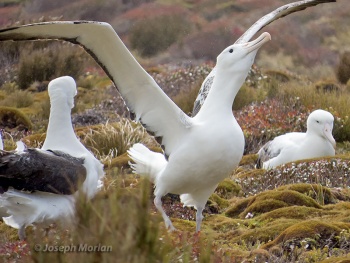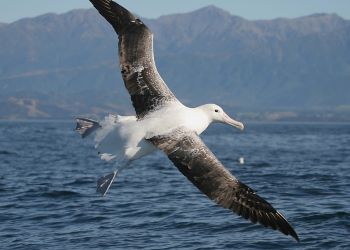- Diomedea epomophora
Identification
- Length around 120 cm, wingspan around 3.2 m -- One of the largest Albatrosses and birds in the world.
- Head and body white
- Tail white except usually black tips on some feathers
- Upperside of wing black flight feathers and some coverts especially on the hand, but front of wing white to the carpal area and coverts more extensively white closer to the body
- Underside of wing white except for narrow black trailing edge and very narrow black line on leading edge of primaries
- Bill pale pinkish with black cutting edge and yellow tip
- Eyes black
- Legs pale pinkish to bluish
Immature: The first full plumage resembles adult but has dark vermiculations on lower back and largely blackish upperwing with white mottling in centre of inner wing, black mottling on crown and black on tail. Next stage has white leading edge of upperwing and the central wing whiter. It takes three more stages for the upper wing to become adult. Underwing shows black tip and narrow black trailing edge.
Variation
Males are reportedly more white on wings than females, and averages larger.
Similar Species
Northern Royal Albatross: the upperwing is completely blackish except for a small white wedge at the base of the leading edge to the base of the central wing, and therefore difficult to separate, especially in the first plumage. Underwing is white with black primary tips and trailing edge plus the diagnostic dark wedge from carpal joint to wing-tip. Juveniles similar to Southern but have brown speckling on head, dark vermiculations on lower back and narrow black tip to tail. Only seem to have two plumage stages.
The species formerly in Wandering Albatross (Snowy Albatross, Tristan Albatross, Antipodean Albatross, and Amsterdam Albatross) mostly lack the black cutting edge on the bill, except for Amsterdam which is much darker in body and head. Size of these vary from similar to slightly larger, but this is useless as a diagnostic when viewed at sea. The paler of these species have the upperwing whitening from a central wedge rather than from the leading edge backwards.
Distribution
Breeds only in New Zealand, with colonies on Campbell (most) and Auckland Islands - a few seems to hybridize with Northern Royal Albatross at Taiaroa Head, Otago, South Island, and the reverse happening at Enderby Island in the Aucklands.
Much less common away from breeding sites than members of the Wandering Albatross complex but occurs north to Tropic of Capricorn across the Pacific and on the east coast of South America.
Taxonomy
Northern Royal Albatross was formerly included in this species.
Subspecies

Photo © by Joseph Morlan
Enderby Island, New Zealand, 6 January 2017
This is a monotypic species[1].
Habitat
Breeds biennially on grassy plateau on remote islands, otherwise at sea but follows ships less frequently than Wandering Albatross.
Behaviour
Breeding
Birds start breeding around 6-12 years of age. Most eggs layed November to December, hatchlings appear in February, and fly off in October. Nest is a large bowl made of mud and vegetable matter in grassy clumps about 180-350 m above the sea. One white egg, often with pinkish-brown blotches (127 x 79mm). Incubated by both parents for about 70 days and young fed by both parents.
Diet
Squid and fish, mostly taken close to the surface, sometimes includes refuse from ships such as fishing fleet. Mostly alone at sea, though can be more than one near a fishing vessel.
Vocalisations
Generally silent though may utter harsh croaking sounds when competing for food at sea. On or near breeding grounds, they make an array of sounds including bill claps, which is not significantly different from the sounds of Northern Royal Albatross.
References
- Clements, J. F., P. C. Rasmussen, T. S. Schulenberg, M. J. Iliff, T. A. Fredericks, J. A. Gerbracht, D. Lepage, A. Spencer, S. M. Billerman, B. L. Sullivan, and C. L. Wood. 2023. The eBird/Clements checklist of Birds of the World: v2023. Downloaded from https://www.birds.cornell.edu/clementschecklist/download/
- Gill, F, D Donsker, and P Rasmussen (Eds). 2023. IOC World Bird List (v 13.2). Doi 10.14344/IOC.ML.13.2. http://www.worldbirdnames.org/
- Jaramillo, A. 2003. Birds of Chile. Princeton & Oxford: Princeton Univ. Press. ISBN 978-0691117409
- del Hoyo, J., C. Carboneras, F. Jutglar, N. Collar, and G. M. Kirwan (2023). Southern Royal Albatross (Diomedea epomophora), version 1.0. In Birds of the World (F. Medrano and B. K. Keeney, Editors). Cornell Lab of Ornithology, Ithaca, NY, USA. https://doi.org/10.2173/bow.royalb2.01
- Marchant, S.; Higgins, P.J. (eds) 1990. Handbook of Australian, New Zealand and Antarctic birds. Vol.1, ratites to ducks. Oxford University Press, Melbourne.
- Moore, P.J. 2013. Southern royal albatross. In Miskelly, C.M. (ed.) New Zealand Birds Online. http://www.nzbirdsonline.org.nz
- Shirihai, H. 2008. Complete Guide to Antarctic Wildlife: Birds and Marine Mammals of the Antarctic Continent and the Southern Ocean. Princeton & Oxford: Princeton Univ. Press. ISBN 978-0691136660
- Pearman, M., J.I. Areta 2021. Birds of Argentina and the South-west Atlantic. Princeton Field Guides, Princeton University Press, Princeton and Oxford. ISBN: 978-0-691-14769-7
Recommended Citation
- BirdForum Opus contributors. (2025) Southern Royal Albatross. In: BirdForum, the forum for wild birds and birding. Retrieved 30 April 2025 from https://www.birdforum.net/opus/Southern_Royal_Albatross
External Links
GSearch checked for 2020 platform.1





